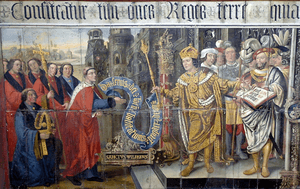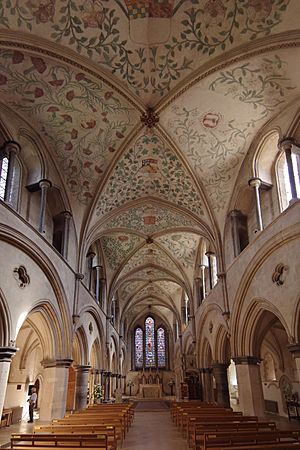Lambert Barnard facts for kids
Lambert Barnard (born around 1485, died 1567) was an English painter during the exciting time of the Renaissance. He was also known as Lambert Bernardi. Barnard created many beautiful paintings, especially for churches and important buildings. His artwork can still be seen today in places like Chichester Cathedral.
Quick facts for kids
Lambert Barnard
|
|
|---|---|

Painting by Lambert Barnard for Chichester Cathedral; depicts the event in 686 when King Cædwalla issued a charter confirming the rights and territories previously given to Wilfrid by King Aethelwealh and the estate of the Hundred of Pagham. Note: the man in white looking over the left shoulder of the king is believed to be a self-portrait of Barnard
|
|
| Born | c.1485 |
| Died | 1567 |
| Nationality | English |
| Other names | Lambert Bernardi |
| Known for | painting |
|
Notable work
|
The Nine Ladies Worthy, The Amberley Panels, The Chichester Cathedral Charter Paintings |
Contents
Who Was Lambert Barnard?
We don't know exactly where Lambert Barnard was born. However, all of his surviving paintings are found in and around the city of Chichester in England. Painting must have run in his family! His son, Anthony Barnard, and his grandson, also named Lambert, followed in his footsteps. Several generations of painters in his family continued to live and work in Chichester.
Barnard used different painting techniques. He often painted directly onto dry plaster walls, a method called fresco. He also used oil paints on wooden boards. His paintings are known for their bright, rich colours, strong black outlines, and shiny gold details. Sometimes, later artists painted over his work, which made it harder to see his original delicate style. But even so, we can tell he knew a lot about art from other parts of Europe at the time.
This suggests he might have learned his skills in a workshop in France or Flanders (an area that is now parts of Belgium, France, and the Netherlands). Around 1513, he started working for Robert Sherborn, who was the Bishop of Chichester from 1508 to 1536. Barnard had a small workshop with an apprentice boy and his son, Anthony, who likely helped him with his projects.
In 1533, Bishop Sherborn asked the church leaders at Chichester Cathedral to give Barnard a yearly payment. This was to thank him for his "long and good service." After the bishop died in 1536, Barnard continued to live in Chichester. He kept getting his yearly payment and sometimes updated his paintings of kings and bishops in the cathedral. He also helped repair other artworks there.
What Did Barnard Paint?
Over about twenty years, Barnard worked closely with Bishop Sherborn on many projects.
- Chichester Cathedral Vaults: Starting around 1513, he painted the ceilings of Chichester Cathedral. These paintings featured plants and family symbols (heraldry).
- Vicar's Close Wall Painting: He also created a wall painting in a house in Vicar's Close in Chichester.
- The Amberley Panels: Around 1526, he painted a series called "The Nine Ladies Worthy" or "Heroines of Antiquity." These paintings, known as "The Amberley Panels," were made for one of the bishop's homes, Amberley Castle.
- Bishop's Palace Ceiling: Between 1524 and 1528, he painted the ceiling of the Tudor Room in the Bishop's Palace in Chichester. This ceiling also featured Italian-style family symbols.
Chichester Cathedral Charter Paintings
Barnard's most important work is the "Chichester Cathedral Charter History Paintings," completed in 1533. This large series of paintings was originally displayed in the south part of Chichester Cathedral.
The paintings tell the story of the cathedral's early beginnings:
- One part shows the church's first home in Selsey. It depicts King Caedwalla of West Saxon giving the land to St. Wilfrid.
- The other part shows the church continuing in Chichester. It features King Henry VIII confirming his royal protection for Chichester Cathedral to Bishop Sherborn.
These two main panels are joined together. Below them are round paintings of the early kings and queens of England. Today, these paintings hang in the south part of the cathedral.
After the cathedral's tall spire fell down in 1861, the rest of the paintings were moved. These included round paintings of the Bishops of Selsey and Chichester, which are now in the north part of the cathedral. Together, these artworks also comment on the historic power of the Roman Catholic Church in England. They also touch on the political changes leading up to the the Reformation, a big religious shift in England. Because these paintings are dated to 1533, they are a very important example of English art from that time.
Other Known Works
Lambert Barnard seems to have spent his entire working life in and around Chichester. However, he did work on a few other projects nearby.
Around 1532, he was hired by Thomas West, who was a friend of Bishop Sherborn. Barnard decorated the ceilings of nearby Boxgrove Priory with West's family symbols.
Some people also believe that a "Mr. Barnard" who supplied a lost altarpiece (a painting behind an altar) for a church in Westminster in 1545 might have been Lambert Barnard. This altarpiece was called the Conception.
There is also a very old book in the British Library called "Troy Book and Siege of Thebes" by John Lydgate. This book was made for Sir William Herbert before 1462 and had some illustrations. Between 1516 and 1523, seventeen more small paintings were added to the book. Some experts have suggested that Lambert Barnard painted these. However, this idea is not fully proven, and some historians say the connection is "very tentative," meaning it's not very strong.
Lambert Barnard's surviving paintings are quite rare. They are important because they show us what English regional art was like in the early 1500s, outside of the royal court.


